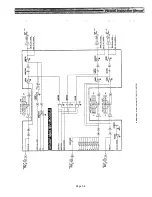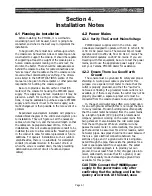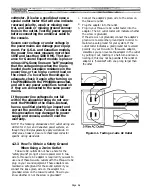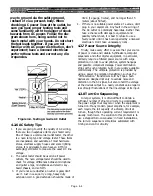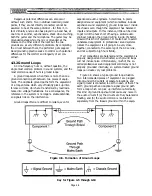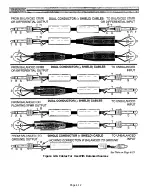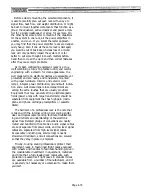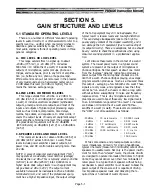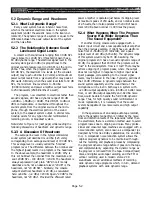
Dangerous potential differences can also occur
without such shorts. Two individual localized ground
points, if they are not directly connected, cannot be
assumed to be at the same potential – far from it, in
fact. Virtually anyone who has played in a band has, at
one time or another, experienced a shock when touching
both the guitar and the microphone. The guitar may be
grounded onstage while the mic is grounded at the
console on the other side of the room but the two
grounds are at very different potentials. By completing
the circuit between them, the performer gets zapped.
Good grounding practice seeks to control such potential
differences for the comfort and longevity of all con-
cerned.
4.3.2 Ground Loops
AC line-frequency hum is, without question, the
single most common problem in sound systems, and the
most common cause of hum is ground loops.
A ground loop occurs when there is more than one
ground connection path between two pieces of equip-
ment. The duplicate ground paths form the equivalent
of a loop antenna which very efficiently picks up inter-
ference currents, which are transformed by lead resis-
tance into voltage fluctuations. As a consequence, the
reference in the system is no longer a stable potential,
so signals ride on the interference.
Ground loops often are difficult to isolate, even for
experienced audio engineers. Sometimes, in poorly
designed sound equipment (which sometimes includes
expensive sound equipment), ground loops occur inside
the chassis even though the equipment has balanced
inputs and outputs. In this instance, little can be done
to get rid of the hum short of having a skilled audio
engineer redesign the ground wiring inside. It’s better
to avoid this kind of equipment. It is also best to avoid
unbalanced equipment in professional sound systems
(unless the equipment is all going to be very close
together, connected to the same leg of the AC service,
and not subject to high hum fields).
If all connections are balanced and the equipment is
properly designed and constructed, such ground loops
will not induce noise. Unfortunately, much of the so-
called professional sound equipment sold today is not
properly grounded internally, so system-created ground
loops can create very real problems.
Figure 4-5 shows a typical ground loop situation.
Two interconnected pieces of equipment are plugged
into grounded AC outlets at separate locations, and
signal ground is connected to earth in each of them. The
earth ground path and duplicate signal ground path
form a loop which can pick up interference. Normally,
this kind of ground loop should not cause any noise in
the audio circuits if (a) the circuits are truly balanced or
floating, and (b) the audio common is maintained
separately from the chassis ground within the equip-
Figure 4-5. Formation of Ground Loops
Key for Figure 4-5 through 4-10
Page 4-6
Summary of Contents for PM4000
Page 1: ...PROFESSIONAL AUDIO MIXING CONSOLE PM4000 OPERATING MANUAL YAMAHA ...
Page 2: ...PM4000 OPERATING MANUAL ...
Page 7: ...Section 1 Introduction ...
Page 11: ...Section 2 Brief Operating Instruction ...
Page 47: ...Section 3 Specifications ...
Page 51: ...Dimensional Drawings PM4000 Console all versions Page 3 4 ...
Page 52: ...Page 3 5 ...
Page 53: ...Page 3 6 PM4000 Console Rear Profiles ...
Page 54: ...Module Block Diagrams See back of the manual for overall system block diagram Page 3 7 ...
Page 55: ...Page 3 8 ...
Page 56: ...Page 3 9 ...
Page 57: ...Page 3 10 ...
Page 58: ...Page 3 11 ...
Page 59: ...Page 3 12 ...
Page 60: ...Section 4 Installation Notes ...
Page 72: ...Figure 4 13 Cables For Use With Balanced Sources Page 4 12 ...
Page 79: ...SECTION 5 Gain Structure and Levels ...
Page 82: ...Figure 5 1 Dynamic Range and Headroom in Sound Systems Page 5 3 ...
Page 86: ...Section 6 Optional Functions ...
Page 106: ...Section 7 Operating Notes and Hints ...
Page 119: ...Section 8 Applications ...
Page 127: ...Section 9 Maintenance ...
Page 131: ......
Page 132: ...YAMAHA VN02300 ...





